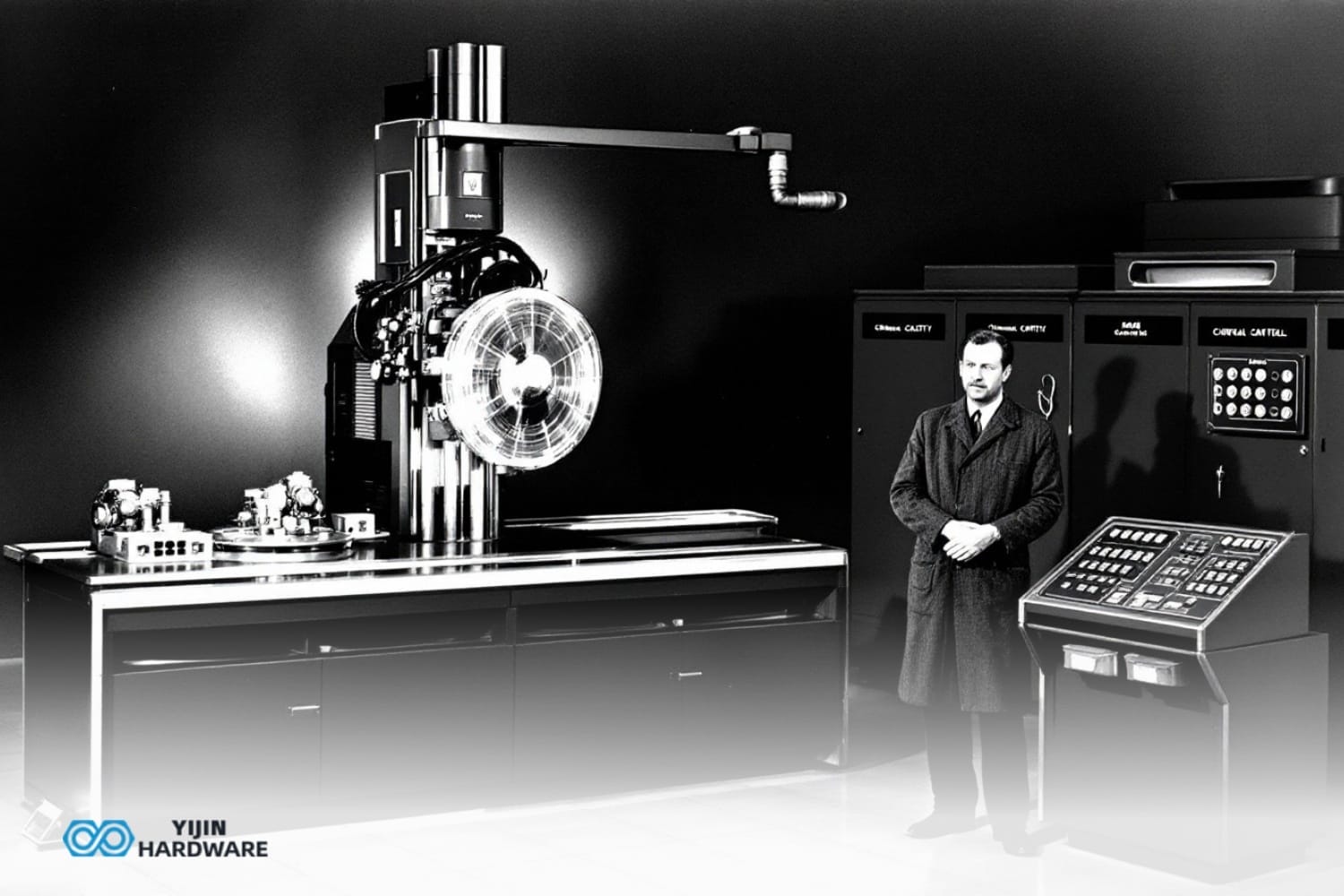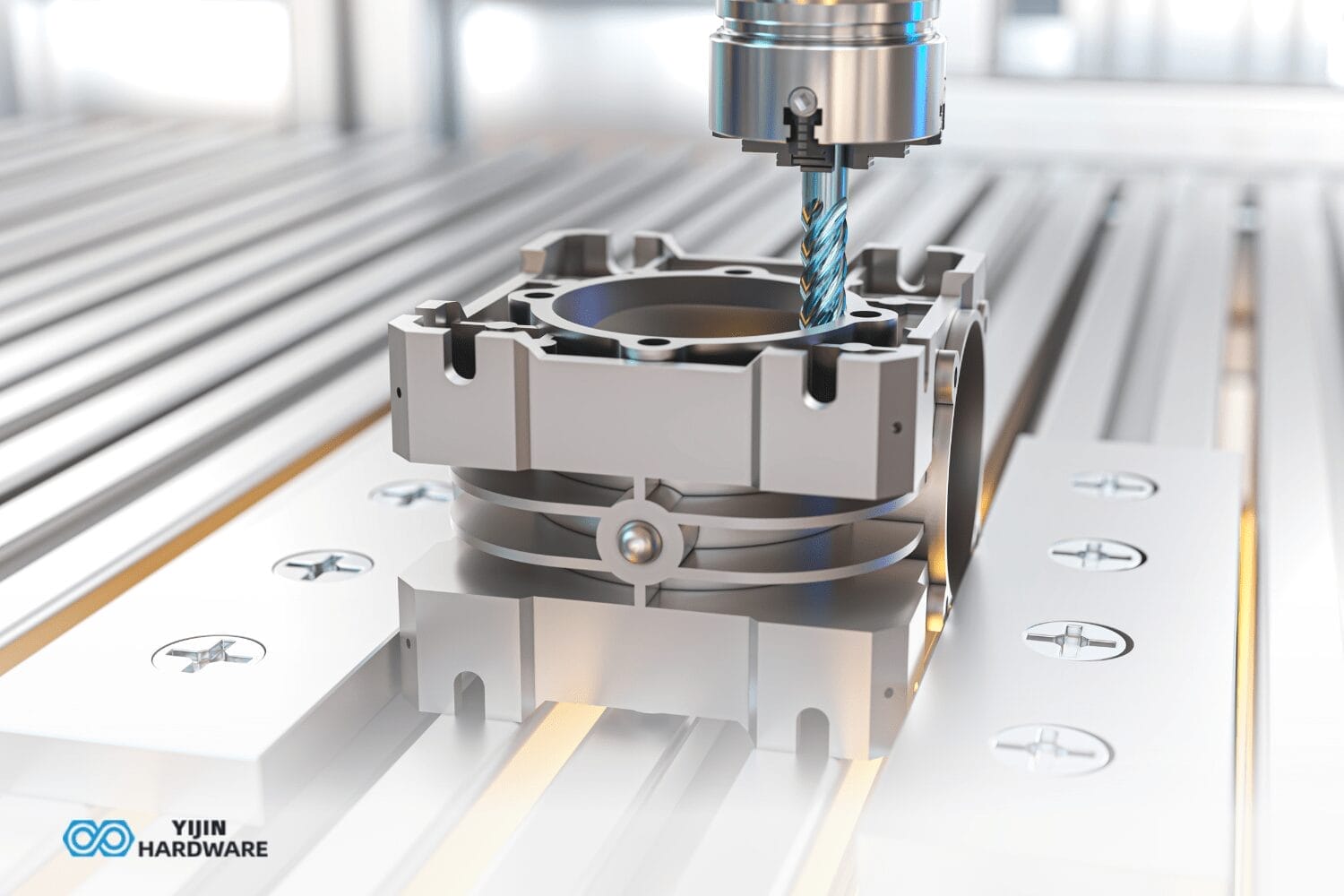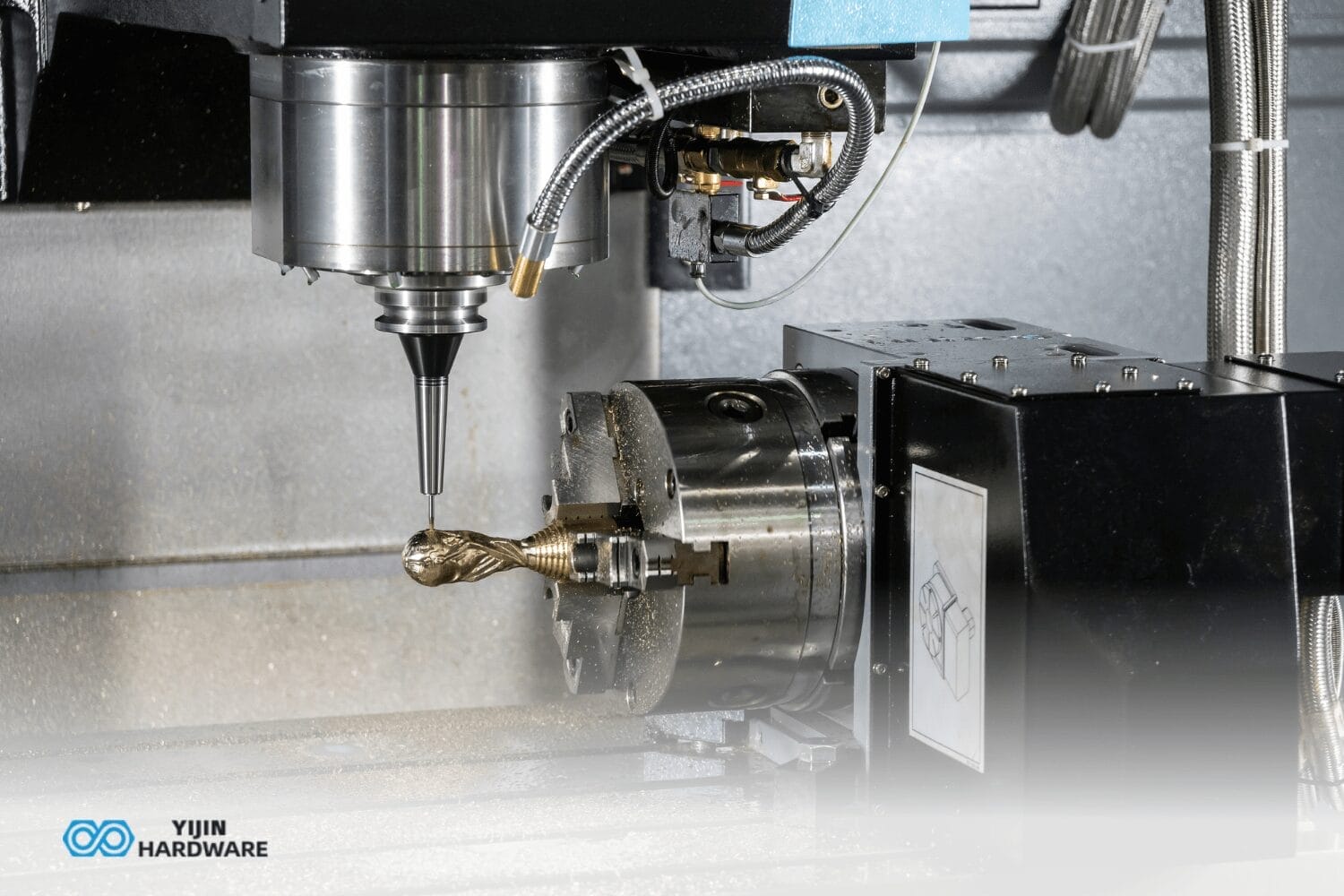What is CNC Machining History and Why does it Matter?
The history of CNC (Computer Numerical Control) machining represents manufacturing’s most significant technological revolution of the 20th century. Beginning in the 1940s with numerically controlled systems that achieved precision of ±0.001 inches, it evolved through computerization in the 1960s, microprocessor integration in the 1970s, and digital connectivity in recent decades. This technological evolution transformed the manufacturing process by replacing inconsistent manual methods with programmable automated systems capable of producing complex components with unprecedented accuracy of ±0.0001 inches.
The significance of this evolution extends across all major industries. Before computer numerical control, manufacturing complex parts required highly skilled craftsmen using manual techniques that were time-consuming, inconsistent, and limited in complexity. A part that might take 8–10 hours to produce manually can now be completed in 30–90 minutes with 5-10× greater precision. This technological revolution has enabled the production of components essential for modern aerospace, automotive, medical devices, and consumer electronics that would be impossible to manufacture manually.
This comprehensive history examines how what began with punch cards and vacuum tubes evolved into today’s multi-axis digital systems used worldwide to produce complex components with remarkable consistency across critical manufacturing industries.
How did Manufacturing Work Before CNC Machines?
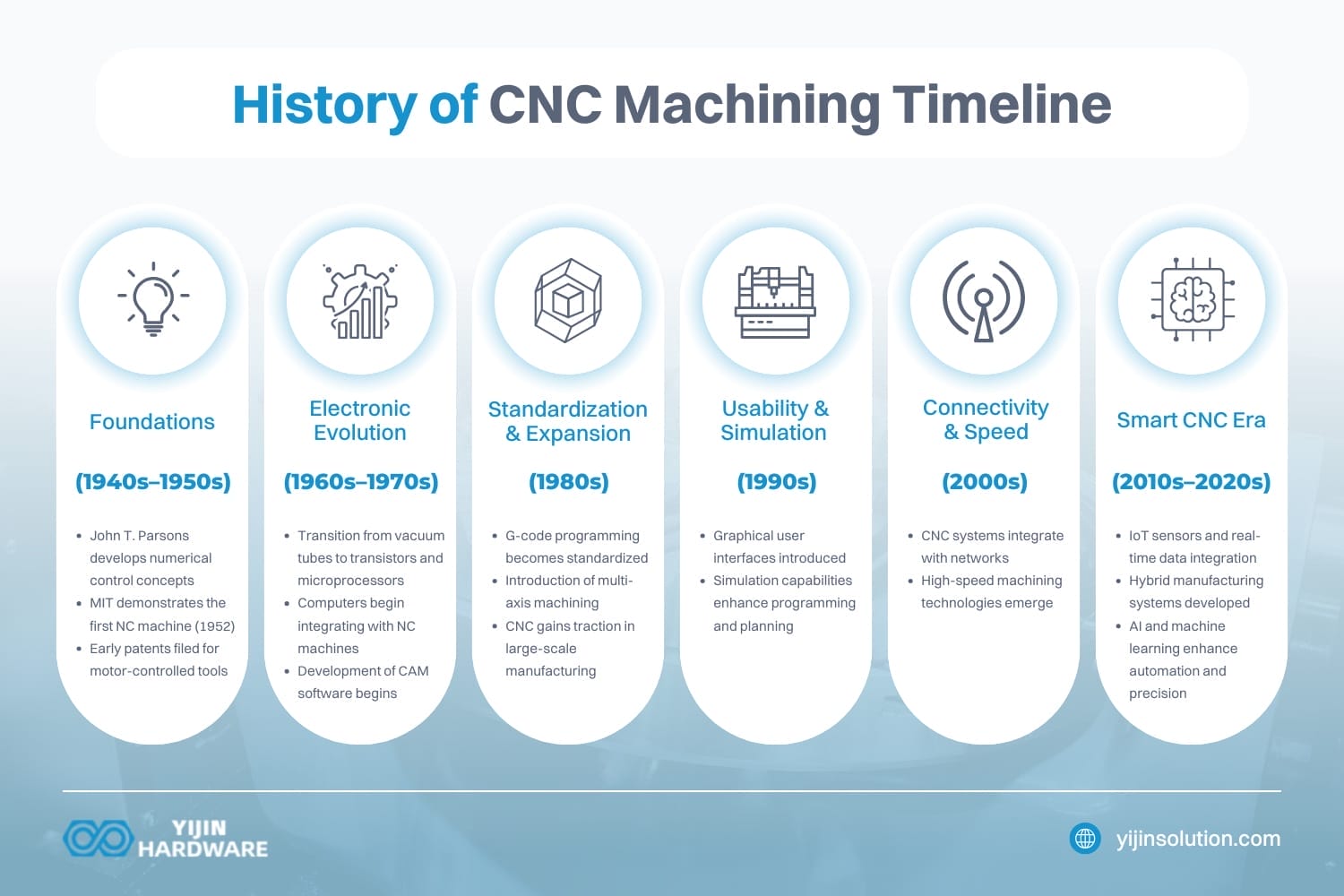
When did Precision Machining First Emerge?
Precision machining can be traced back to 1751 with the invention of a metal-frame turning machine, representing early efforts to standardize mechanical processes. For nearly two centuries afterward, manufacturing relied entirely on manual methods, with significant limitations that ultimately drove the need for automation.
Before automated control, manufacturing depended on four primary manual approaches:
- Manual Machine Tools: Hand-operated lathes, mills, and drills requiring constant operator attention
- Skilled Craftsmen: Specialists with 5–10 years of apprenticeship training
- Mechanical Templates: Physical guides that helped reproduce basic shapes
- Direct Measurement: Manual verification using calipers and gauges
These traditional machining processes created critical limitations:
- Inconsistency: Part variations of 0.01-0.05 inches between identical components
- Limited Complexity: Inability to produce mathematically complex contours
- Time Requirements: Parts taking 5-10× longer than automated methods
- Skill Dependency: Quality varying based on operator expertise
Why was Automation Needed in Manufacturing?
Manufacturing automation became necessary in the 1940s due to four converging pressures that manual methods couldn’t address. World War II created unprecedented demand for precision components, aerospace advancement required tolerances below 0.001 inches, economic competition demanded greater efficiency, and increasingly complex designs exceeded manual capabilities.
These manufacturing challenges created the perfect environment for technological innovation:
- World War II Demand: Military production requiring 300-500% increased output
- Aerospace Requirements: Parts with mathematical precision impossible to achieve manually
- Economic Pressure: Market competition requiring 40-60% efficiency improvements
- Design Complexity: Contoured surfaces defined by mathematical equations
The intersection of these factors made the development of automated control systems for machine tools not merely desirable but essential for industrial advancement.
How was Numerical Control Born in the 1940s?

Who Invented the First Numerical Control System?
John T. Parsons invented the first numerical control system in 1949 while at Parsons Corporation in Michigan. His breakthrough innovation used an IBM 602A multiplier to calculate precise airfoil coordinates, transferred to punch cards, and fed into a Swiss jig borer to control cutting operations—achieving position accuracy of ±0.001 inches for helicopter blade templates. This marked the birth of numerically controlled machine tools that would revolutionize manufacturing.
Parsons’ pioneering implementation followed these innovative steps:
- Mathematical calculation of coordinates using the IBM 602A
- Transfer of coordinates to standard IBM punch cards
- Card-controlled operation of a modified Swiss jig borer
- Production of helicopter blade templates with unprecedented precision
This groundbreaking approach earned Parsons recognition as “The Father of the Second Industrial Revolution” and the National Medal of Technology for fundamentally transforming manufacturing capabilities. The 1940s, when the first numerical control system was developed would prove to be a pivotal moment in manufacturing history.
What Role did MIT Play in Early NC Development?
The Massachusetts Institute of Technology transformed numerical control from concept to reality through their Servomechanisms Laboratory research starting in 1949. With $175,000 in U.S. Air Force funding, MIT researchers created the first practical numerically controlled machine by developing servo motors for precise axis control, building vacuum tube electronic control systems, and designing interfaces that translated engineering specifications into machine instructions.
MIT’s research team focused on four critical technological innovations:
- Creating machines that could follow punched tape coordinate instructions
- Developing closed-loop servo motors that maintained position accuracy to ±0.0005″
- Building electronic control systems using 250 vacuum tubes and 175 relays
- Designing programming interfaces for converting engineering drawings to machine code
This academic-military-industry partnership established the collaborative model for technological innovation that would drive manufacturing advancement for decades to come. The development of the first CNC system at MIT laid the groundwork for all future advances in automated machining.
What Were the First NC Machines Like (1952-1958)?
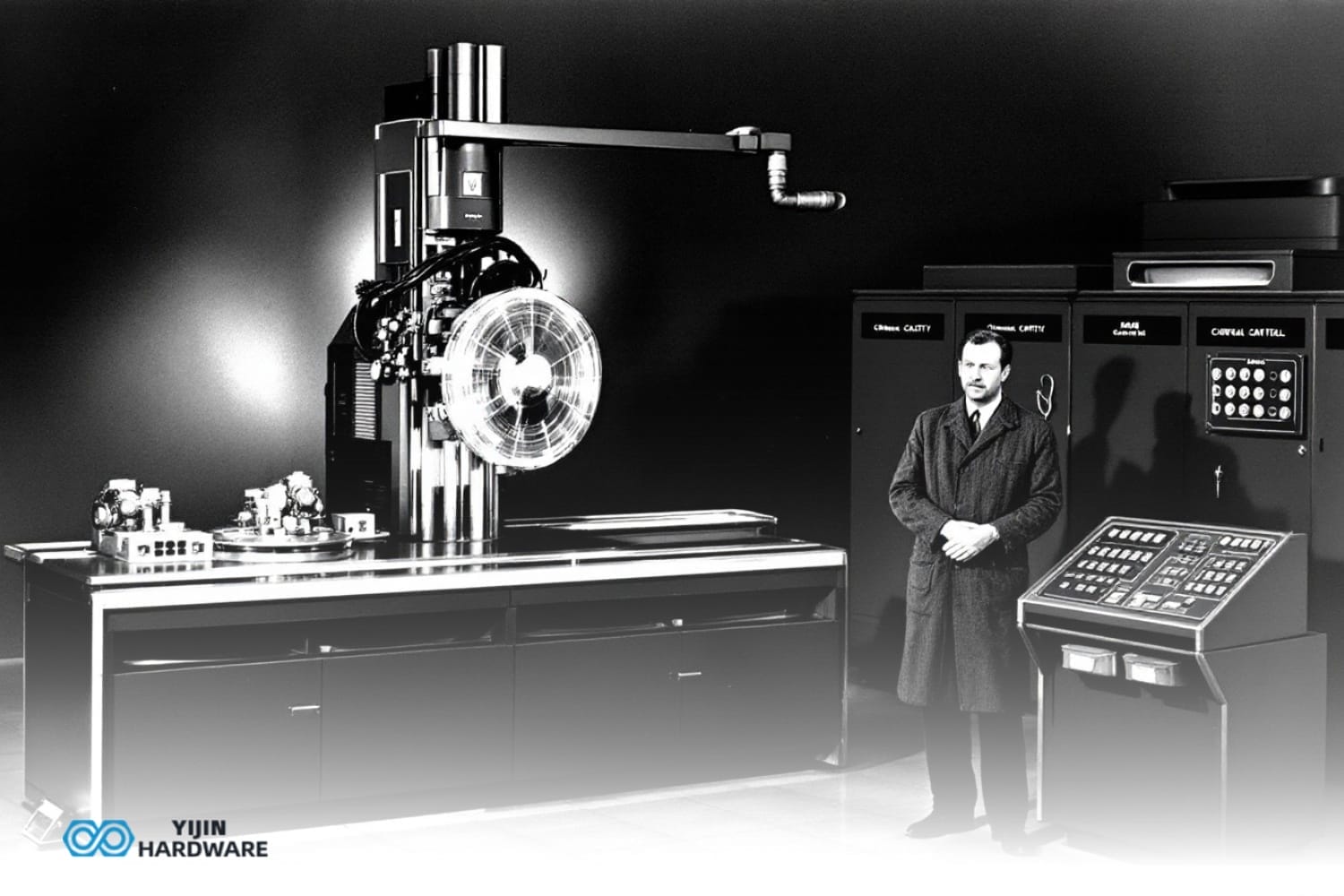
How did MIT’s First Demonstration Machine Work?
MIT’s 1952 NC machine demonstration featured a modified Cincinnati Milling Machine Company Hydrotel milling machine controlled by a room-sized system with 175 relays and 250 vacuum tubes. This first true numerically controlled milling machine demonstrated automated three-axis movement with ±0.001″ accuracy using punched tape input—proving that programmed instructions could consistently produce complex parts without continuous operator intervention.
The revolutionary machine incorporated four key technologies:
- Electronic Control System: Vacuum tube circuits filling an entire control cabinet
- Three-Axis Movement: Automated X, Y, and Z axis coordination
- Servo Motor Feedback: Early closed-loop positioning systems
- Punched Tape Input: Programming via 1-inch paper tape with 8 channels
The demonstration machine, funded at approximately $360,000 ($3.9 million today), successfully produced the first Joseph Marie Jacquard memorial ashtrays as proof-of-concept, validating NC principles and attracting interest from industry and military representatives.
What Legal and Patent Milestones Shaped Early CNC Development?
Critical legal developments established the commercial foundation for numerical control technology in the late 1950s. In 1958, Richard Kegg from the Cincinnati Milling Machine Company filed U.S. Patent #2,820,187 for “Motor Controlled Apparatus for Positioning a Machine Tool,” which documented the fundamental principles that would guide CNC development for decades. This patent marked the development of CNC as we know it today.
This pivotal patent covered four essential components of NC systems:
- Methods for translating coded instructions into precise movements
- Coordinate systems controlling multiple axes simultaneously
- Feedback mechanisms to maintain positional accuracy during operation
- Integration of cutting operations with automated tool positioning
The patent’s commercial impact was profound:
- Bendix Corporation purchased MIT’s patent rights for $200,000 in 1953
- Legal protection enabled $3-5 million investment in early commercial development
- Patent licensing established manufacturing standards across different companies
- Cross-licensing agreements helped standardize control systems and programming
These legal frameworks transformed experimental technology into commercial products, while establishing the technological standards that would guide future development of CNC machinery.
How did Early NC Machines Store and Execute Programs?
Early NC machines used punch tape technology to store machine instructions through precisely positioned holes in paper or Mylar strips. Each inch of tape stored approximately 8–10 bytes of data through patterns of holes that optical or mechanical readers translated into electrical signals for controlling machine movements. Later systems would also use magnetic tape as storage media for numerically controlled machine tools.
The punch tape system operated through this sequence:
- Pattern Creation: Machine commands encoded as specific hole patterns
- Mechanical Reading: Optical or contact-based readers scanning the patterns
- Electronic Translation: Converting hole patterns into electrical control signals
- Machine Actuation: Directing precise tool movements (±0.001″)
This system represented a revolutionary advance but faced significant limitations:
- Physical Fragility: Tapes tore or damaged easily, with 30-50% requiring replacement
- Editing Difficulty: Changes required creating entirely new tapes (8-12 hours per edit)
- Storage Constraints: Complex programs required 20+ feet of cumbersome tape
- Programming Complexity: Creating programs required specialized knowledge
Despite these constraints, punch tape technology served as the crucial bridge between manual operation and computerized control that would emerge in the following decade. The early CNC machines were revolutionary, but still limited compared to what machines became in later decades.
When did Computers Transform NC into CNC (1960s-1970s)?
How did NC Evolve into CNC?
NC evolved into true computer numerical control during the 1960s through computer integration that revolutionized machine tool control. This transformation replaced fixed punch tape with editable computer memory, eliminated time-consuming tape creation for program changes, added real-time position feedback within 0.0005″, enabled more complex operations, improved user interfaces, and dramatically enhanced programming flexibility.
The key differences between NC and CNC systems show this fundamental transformation:
| Feature | NC Systems (1950s) | CNC Systems (1960s) |
|---|---|---|
| Programming | Fixed punch tape programs | Editable computer memory storage |
| Editing | New tape creation (8-12 hours) | Keyboard modifications (minutes) |
| Feedback | Limited or no position feedback | Real-time 0.0005″ position feedback |
| Complexity | Limited by physical media | 5-10× more complex operations |
| Interface | Basic operator controls | Digital displays and controls |
| Flexibility | Programs difficult to modify | Easy program editing and optimization |
The 1967 introduction of the first CNC milling machine by Electronic Data Control Company, featuring an integrated computer system, marked the definitive transition to the CNC era. This brief history milestone fundamentally changed how machining operations would be performed.
Why did G-Code Become the Standard Programming Language?
G-code emerged as the universal CNC programming language in the 1960s and was standardized as RS-274D by the Electronic Industries Alliance in 1980. This standardization occurred because G-code offered five key advantages: straightforward syntax for both humans and machines, direct representation of tool movements and functions, transferability between different machine types, extensibility for specialized operations, and efficient execution requiring minimal processing.
G-code uses a letter-address format where:
- G-commands (G00, G01, G02) control motion type (rapid positioning, linear interpolation, circular interpolation)
- M-commands (M03, M08, M30) control machine functions (spindle on, coolant on, program end)
- Coordinate values (X, Y, Z) specify tool positions
- Feed/speed values (F, S) control cutting parameters
A typical G-code command like G01 X100 Y50 F300 instructs the machine to:
- Move in a straight line (G01)
- To position X=100mm, Y=50mm
- At a feed rate of 300 mm/min
This standardization created a common language that remains fundamental to CNC programming despite numerous higher-level programming advances. Modern CNC machines still execute G-code, though it’s now typically generated by CAM software rather than written manually.
How has CNC Programming Evolved Over Time?
CNC programming has evolved through four distinct phases since its inception, with each advancement making programming more accessible and capable of handling increasingly complex parts:
- Punch Tape Era (1950s-1960s):
- Physical media encoding machine instructions through hole patterns
- Manual coordinate calculation, requiring 40–80 hours for complex programs
- Program verification requiring actual machine testing
- Changes requiring completely new tape creation
- APT Language Development (1956-1970s):
- High-level programming focused on geometry rather than machine movements
- Commands like POINT, LINE, CIRCLE defining part features
- Compiler translation to machine-specific instructions
- 40-60% faster programming for complex parts
- Interactive Programming (1970s-1980s):
- Computer terminals allowing direct machine programming
- Menu-driven interfaces with graphical aids
- Conversational programming simplifying complex operations
- Shop floor programming, reducing dependence on specialists
- Modern CAD/CAM Integration (1980s-Present):
- Seamless workflow from computer-aided design models to machine instructions
- Virtual toolpath verification with 99.5% correlation to actual cutting
- Feature-based programming automating common operations
- Parametric programming, allowing rapid modification of part families
This evolution has transformed CNC programming from a specialized skill requiring deep technical knowledge to a largely automated process that can translate complex designs directly into machine instructions. As companies recognize the advantages of CNC machining, programming has become more accessible and powerful.
How did Microprocessors Revolutionize CNC in the 1970s?
Microprocessors revolutionized CNC technology in the 1970s by shrinking control systems by 90%, reducing costs from $120,000+ to under $30,000, improving reliability with mean time between failures increasing 300%, enhancing processing speeds 10–20 times, and creating visual interfaces that replaced text-based systems—making CNC technology accessible to smaller manufacturers.
These microprocessor innovations transformed CNC through five key advances:
- Size Reduction: Controllers shrank from room-sized units to desktop cabinets
- Cost Decrease: Entry-level CNC systems dropped below $30,000 by 1979
- Reliability Improvement: Solid-state electronics increased uptime to 95%+
- Performance Enhancement: The Intel 8080 (1974) enabled complex operations at 2 MHz
- Interface Revolution: Text commands evolved into visual programming systems
This democratization expanded CNC from approximately 20,000 installations in 1970 to over 100,000 by 1980, transforming it from a specialized technology into a mainstream manufacturing tool. The Lewis Machine Tool Co was among the companies that helped produce the machines with these new capabilities, making CNC machinery more accessible to a wider range of manufacturers.
How did Digital Manufacturing Evolve (1980s-Present)?
When did CAD/CAM Integration Change CNC Programming?
Computer-aided design integration with CNC began in 1976, creating a unified digital manufacturing environment. This pivotal development directly translated 3D models into machine instructions with 90% fewer errors, enabled complex geometries with 5-axis tool paths impossible to program manually, reduced programming time by 40-70%, and improved collaboration between design and manufacturing teams.
This integration created four transformative capabilities:
- Digital Continuity: Seamless data flow from design to production
- Error Reduction: Eliminating manual translation errors between design and manufacturing
- Complexity Enablement: Production of complex geometries defined mathematically
- Efficiency Gains: Reducing programming time from 100+ hours to 30–60 hours
By 1989, these advances combined with graphical user interfaces, standardized programming languages, and improved system compatibility to establish CNC as the industry standard for precision manufacturing worldwide. The advantages of CNC machining became increasingly evident as this integration streamlined the entire manufacturing process, particularly for large-volume production.
What Technical Innovations Define Modern CNC Systems?
Modern CNC systems incorporate critical technical distinctions that determine their performance, precision, and appropriate applications. Two fundamental technological choices significantly impact capabilities:
Open-Loop vs. Closed-Loop Systems:
Open-loop systems operate without position feedback using stepper motors with no error detection, achieving ±0.001-0.003″ accuracy that deteriorates under variable loads, costing $500-$3,000 per axis, and suiting lighter applications. Closed-loop systems incorporate encoder feedback providing continuous position monitoring with real-time error correction, maintain ±0.0001-0.0005″ accuracy regardless of cutting forces, cost $2,000-$20,000+ per axis, and are essential for industrial precision machining.
The technical distinctions include:
- Feedback Mechanism: Optical or magnetic encoders in closed-loop systems provide 1,000-10,000+ position checks per revolution
- Error Handling: Closed-loop systems can detect position errors within 10–50 milliseconds and apply automatic correction
- Stability Under Load: Closed-loop systems maintain accuracy even when cutting forces vary by 50-100%
- Power Requirements: Closed-loop systems typically require 20-30% more power but deliver 40-60% more consistent results
Stepper vs. Servo Motors:
| Feature | Stepper Motors | Servo Motors |
|---|---|---|
| Motion type | Discrete steps (200-400 steps/revolution) | Continuous rotation with feedback |
| Feedback system | Typically, none (open-loop) | Encoders providing 1,000-10,000+ counts/revolution |
| Speed performance | Torque drops 80% at high speeds | Maintains consistent torque across speed range |
| Precision at low speed | Good (±0.001-0.003″) | Excellent (±0.0001-0.0005″) |
| Cost range | $50-$300 per motor | $200-$2,000+ per motor |
| Typical applications | Engraving, 3D printing, light milling | Production machining, heavy cutting operations |
| Heat generation | Higher heat at high speeds | Lower heat generation at all speeds |
| Noise levels | 65–75 dB during operation | 45–60 dB during operation |
These technological distinctions create the framework for selecting appropriate CNC systems based on application requirements, precision needs, and budget constraints. These capabilities define what today’s CNC machines can achieve with high precision and versatility.
How has CNC Technology Impacted Manufacturing?
Which Industries Rely Most Heavily on CNC Technology?
CNC machining has become critical across diverse manufacturing industries with specific applications tailored to their unique requirements. Jobs such as operating CNC equipment will account for a significant portion of manufacturing employment in these sectors. Each industry leverages CNC technology for different specialized applications:
Aerospace:
- Turbine blades with complex airfoil surfaces requiring ±0.0001″ tolerance
- Titanium and Inconel structural components with 80:1 length-to-diameter ratios
- Fuel system components with internal passages that must meet AS9100D standards
- Satellite components requiring stability in extreme temperature conditions (-150 °C to +150 °C)
Medical:
- Titanium implants with biocompatible surface finishes (0.8-1.6μm Ra)
- Surgical instruments requiring 304/316 stainless steel with specialized coatings
- Orthopedic components with complex anatomical interfaces
- Micro-fluidic devices with channel dimensions as small as 0.1 mm
- Engine components requiring hardened steel with ±0.0005″ tolerances
- Transmission gears with precise involute profiles
- Aluminum manifolds with complex internal flow passages
- Prototype components for test verification before mass production
Electronics:
- Heat sinks with optimized fin geometries for thermal dissipation
- Connector housings with miniaturized features (0.2-0.5 mm)
- Test fixtures with precise alignment requirements (±0.001″)
- EMI shielding enclosures with specialized surface treatments
Specialty Applications:
- Jewelry Production: Micro-machined precious metal settings with 0.1 mm details
- Watchmaking: Components with tolerances of ±0.002 mm for mechanical movements
- Optical Equipment: Mirror mounts requiring stability to within 0.5 arc-seconds
- Racing: Lightweight components with optimized strength-to-weight ratios
This diverse application across industries has made CNC machining a $27 billion global market that continues to grow at 5-7% annually. Companies increasingly rely on CNC machining for critical components.
How has Modern CNC Capability Evolved?
Modern CNC capabilities have expanded dramatically through multi-axis machining, advanced software systems, and integration with broader manufacturing ecosystems. Today’s CNC systems offer five key advanced capabilities:
Multi-Axis Machining: 5-axis simultaneous movement enables complex contoured surfaces in a single setup, reducing cycle times 60-80% compared to conventional 3-axis machines while producing geometries previously impossible to manufacture
Software Intelligence: Modern CAM systems offer simulation verification with 99.5%+ accuracy to real results, adaptive toolpaths that automatically adjust to cutting conditions for 30-50% cycle time reductions, and AI-enhanced optimization that improves efficiency 15-30%
Industry 4.0 Integration: CNC systems now connect to broader manufacturing networks, with IoT connectivity providing real-time data, predictive maintenance systems anticipating failures 2–4 weeks in advance with 85-95% accuracy, and digital twins creating virtual replicas for simulation and optimization
Advanced Safety: Collision prevention systems employ multiple technologies including absolute encoders, torque sensors that detect resistance within 10ms, power monitoring, and simulation verification—reducing collision damage by 80-90%
Hybrid Manufacturing: Combined additive and subtractive approaches enable optimized designs impossible with either technology alone, reducing weight 30-50% while maintaining structural integrity
These capabilities collectively represent the cutting edge of modern CNC technology, continuing the evolutionary path that began with punch cards and vacuum tubes. Significant developments in CNC have occurred in the history of this technology that enable unprecedented manufacturing capabilities.
What Advanced Parts Can Only Modern CNC Technology Produce?
Only modern advanced CNC systems can produce certain categories of extremely complex components that were impossible with previous generations of manufacturing technology:
Aerospace Turbine Components:
- Blisks (bladed disks) with integrated blade and hub designs
- Impellers with 5-axis machined 3D curved surfaces and wall thicknesses of 0.5 mm
- Turbine blades with internal cooling channels requiring 0.0001″ accuracy
- Engine mounts with optimized topologies, reducing weight by 40-60%
Medical Precision Implants:
- Custom cranial implants with patient-specific geometries
- Spinal fusion cages with complex lattice structures for bone integration
- Acetabular cups with precisely controlled surface textures (2-8μm Ra)
- Dental implants with micro-threaded surfaces for osseointegration
Advanced Tooling:
- Injection molds with conformal cooling channels that reduce cycle time by 30-50%
- Die-casting tools with complex internal geometries for improved thermal management
- Composite layup tools with precise contours and controlled thermal expansion
- Press tooling with wear-resistant inserts and optimized geometry
These advanced components demonstrate how modern CNC capabilities continue to push the boundaries of what’s physically possible to manufacture, enabling entirely new categories of high-performance products. Using CNC machining for these applications has revolutionized what’s possible in manufacturing.
What’s Next for CNC Technology?
How Will AI and Sustainability Shape Future CNC Development?
The future of CNC technology is being shaped by two primary forces: artificial intelligence integration and sustainability initiatives. AI is transforming CNC operations through optimized toolpaths that reduce cycle times 15-40%, adaptive control systems adjusting parameters in real-time, predictive quality monitoring identifying issues before they affect parts, and increasing autonomous operation reducing human intervention by 70-90%.
Simultaneously, sustainability is driving development through:
- Energy Efficiency: 30-50% power reduction through optimized motors and systems
- Material Conservation: 15-30% less waste through advanced programming
- Reduced Coolant Usage: 80-100% coolant reduction through advanced tooling
- Lifecycle Management: Comprehensive environmental impact analysis
- Extended Component Life: 2-3× longer service through remanufacturing
These parallel trends are creating the next generation of CNC systems that optimize performance while reducing environmental impact—demonstrating that manufacturing efficiency and sustainability can advance together. CNC specialists are developing these technologies to ensure both productivity and environmental responsibility.
FAQs About CNC Machining History
Who is recognized as the father of CNC machining?
John T. Parsons is recognized as the father of CNC machining for his pioneering work in the 1940s. While working at Parsons Corporation in Michigan, he developed the first numerical control system using an IBM 602A multiplier to calculate coordinates for helicopter blade templates in 1949. Parsons received the National Medal of Technology in 1985 and is widely acknowledged as “The Father of the Second Industrial Revolution” for his contributions that fundamentally transformed manufacturing worldwide.
What specific problem did CNC machining solve when first developed?
CNC machining initially solved five critical manufacturing challenges that manual methods couldn’t address. During the 1940s, aerospace components required precision beyond manual capability (±0.001″ vs. ±0.005-0.010″), complex mathematically-defined contours like helicopter blades were extremely difficult to produce by hand, wartime production demanded faster manufacturing, manual processes couldn’t maintain consistency across multiple parts, and skilled machinist shortages during World War II created workforce challenges—collectively requiring automated precision manufacturing solutions.
How did early NC machines differ from modern CNC systems?
Early NC machines used punch tape programming instead of computer storage, employed analog controls rather than digital systems, featured minimal operator interfaces instead of graphical displays, limited movement to 2-3 axes compared to 5+ axes today, typically operated as open-loop systems without position feedback, functioned as standalone units rather than networked systems, required manual programming calculations instead of CAD/CAM software, operated 5-10× slower, achieved ±0.001″ precision versus ±0.0001″ today, and served limited applications rather than the multi-function capabilities of modern systems.
How did the microprocessor revolution of the 1970s change CNC machining?
The microprocessor revolution transformed CNC machining by shrinking controller size from room-sized computers to desktop cabinets, lowering costs from $120,000+ to under $30,000 for basic systems, improving reliability with mean time between failures increasing from 100 to 1,000+ hours, enhancing processing speeds 10-20× enabling more complex operations, and creating more intuitive programming interfaces—expanding CNC from approximately 20,000 installations in 1970 to over 100,000 by 1980 while making the technology accessible to small and medium manufacturers.
Back to Top: History of CNC Machining | Evolution to the Modern Day


